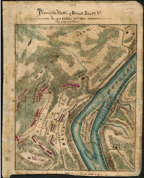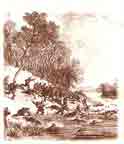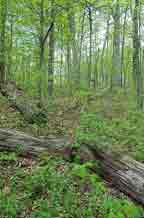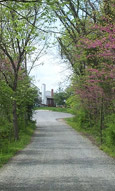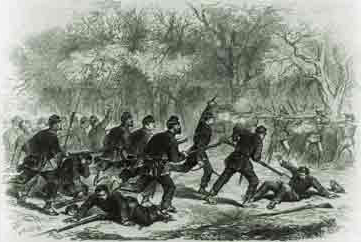 On October 21, 1861, Confederate forces, under Col. Nathan “Shanks” Evans, successfully defended Ball’s Bluff, and the town of Leesburg, from the Union forces led by General Col. Edward Baker. Several nights before the battle, a Federal scouting party, led by Capt. Chase Philbrick, surveyed the terrain and the existence of a possible rebel camp, with at least 30 tents. The Captain reported his team’s findings to General Charles Stone, who ordered troops to take the camp. After raiding the camp and finding nothing except hay, Gen. Stone told the men to hold their position and defend it against attack. He then gave control of the operation to Col. Baker.
On October 21, 1861, Confederate forces, under Col. Nathan “Shanks” Evans, successfully defended Ball’s Bluff, and the town of Leesburg, from the Union forces led by General Col. Edward Baker. Several nights before the battle, a Federal scouting party, led by Capt. Chase Philbrick, surveyed the terrain and the existence of a possible rebel camp, with at least 30 tents. The Captain reported his team’s findings to General Charles Stone, who ordered troops to take the camp. After raiding the camp and finding nothing except hay, Gen. Stone told the men to hold their position and defend it against attack. He then gave control of the operation to Col. Baker.
While the Union troops were moving and establishing their position, the Confederate troops discreetly observed the movement from a vantage point. When the time was right, Col. Evans led his men against the Union troops. The number of men on the battlefield, and the number of men killed, were about the even for both sides. What made this battle a victory for the Confederacy, was the tactics their employed. They had the advantage of higher ground, knowing the terrain, and killing Col. Baker. As the retreat was sounded, many Union men died while trying to escape to the Potomac River.
The Union defeat here, and several months earlier at Manassas, was demoralizing for the North. Congress created a committee to investigate these setbacks, The Committee on the Conduct of the War. The committee also helped to pacify the general public, but did little to improve moral or military discipline. Col. Stone was found guilty of negligence and committing “the most atrocious blunder in history,” in a closed proceeding of the committee where the evidence was based mostly on rumor. 1
Today, Loudoun County is one of the fastest growing counties in the nation. In the few years since 2000, it is estimated that over 5,000 people have moved into the area.2 While still more rural than most of the D.C. area, land is increasingly expensive and being sold in smaller and smaller lots. As the developers use the converted farmland for condos and houses, modern civilization begins to creep nearer to our Civil War Landmarks. The land Ball’s Bluff battlefield occupies is protected, but with the increase of modernization, the feeling of the past is not as powerful.
The park itself is quite dense and wooded. There are several footpaths, around the perimeter, through the middle to the cemetery, and down to the Potomac River. At times, it may be difficult at times to see through some of the trees and vision the battle, but the placards scatter along the perimeter footpath are quite helpful with the interpretation and story telling. However, despite a small sense of seclusion while in the park, the sounds of traffic and airplanes are still noticeable.


